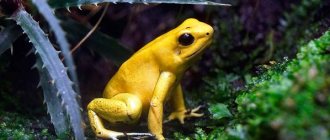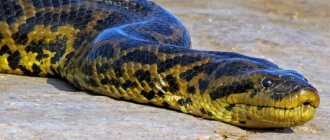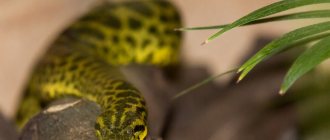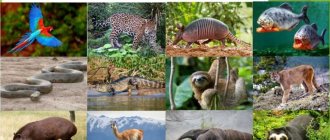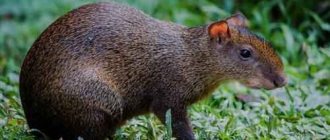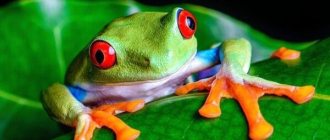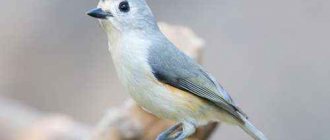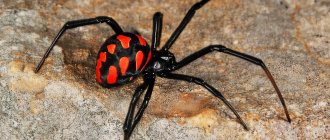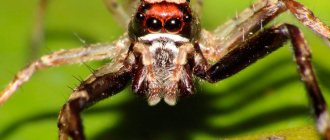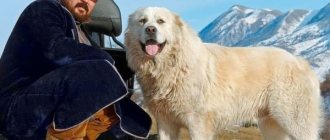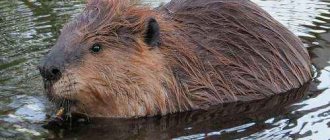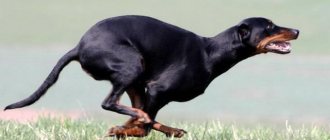Bushmaster appearance
The body of this snake is slender, and in cross-section it looks like a triangle. The snake is covered with ribbed scales.
Bushmaster (Lachesis muta).
Bushmasters reach a length of about 3.6 meters. The head is large, wedge-shaped, the muzzle is narrowed. The scales on the head are thinner than on the rest of the body.
Color yellowish-brown. The body is decorated with a pattern of large dark brown diamonds; thanks to these patterns, the snake is camouflaged among the leaves.
Description
The body length of the surukuku snake is from 2.5 to 3 meters. But there were specimens up to 4 meters. The cross section of the snake's body looks like a triangle. Weight - no more than 5 kg. The color is variegated, characteristic of vipers. Pattern in the form of brown diamonds on a yellowish-brown background.
The end of the tail is hollow with hard scales; when it hits plants and stones, a quiet hum is heard, which is usually compared to the sound of a rattlesnake's rattle.
On the head, which is also typical for all rattlers, there are two pits sensitive to infrared radiation, which allows the snake to hunt successfully. After all, the body temperature of a potential reptile victim is higher than the surrounding air. Thus, with the help of these “primitive eyes” (but the snake itself also has good vision), even in pitch darkness the snake finds its prey. As a rule, these are small mammals, sometimes birds.
Ribbed (keeled) scales, large poisonous teeth (2.5 cm, and according to some sources - up to 4 cm), large eyes with vertical pupils are other distinctive features of the bushmaster snake. In terms of habits and lifestyle, this reptile is closest to the rattlesnake.
Bushmaster Hunt
The bushmaster's diet mainly consists of rodents. These snakes hunt at night. When a snake hunts, it lies on the ground without the slightest movement, burrowing into the leaves and patiently waiting for its prey. Such a hunt can last for weeks. They sit in ambush next to the paths along which animals go to water.
Bushmaster is also called surukuku.
As already noted, the bushmaster is helped to find victims by thermolocators, which are located on the sides of the head, in the recesses between the eyes and nostrils. All representatives of pit snakes have such organs. Biologists have not yet learned all the features of the action of thermolocators. What is clear is that this organ reacts to changes in temperature when a warm-blooded animal approaches. They are able to detect the smallest temperature changes - from just 0.003 degrees.
Not only thermolocators, but also acute vision help snakes track prey. When prey is found, the snake instantly attacks. The bushmaster's poisonous teeth bite into the victim's body, and a large amount of poison enters the wound. This snake has movable jaws, so it can open its mouth wide. The bushmaster swallows the victim whole. Muscles help push food down the esophagus. Digestion of food is carried out by strong gastric juice. Bones and skin are usually completely digested as well.
Lachesis muta (LINNAEUS, 1766) Today we’ll talk about perhaps the most legendary snake in South America, and one of the most legendary in the world. The tribes of the Amazon dubbed it surukku, which translated means pineapple (armored) snake. You and I are used to calling lachesiz in the American way - Bushmaster. After an intraspecific division into several independent species, in order to avoid confusion, it is now also called the Atlantic bushmaster. This amazing snake was described by the grandfather of modern taxonomy, Carl Linnaeus, assigning it to the genus Crotalus, which in general is not surprising. So what did this snake deserve such attention and admiration from almost everyone who, one way or another, loves snakes? In fact, many... For starters, this is the largest snake in the viper family, the recorded record exceeds 3.6 m! The only thing this species may be inferior in is weight (the weight of large bushmasters can reach up to 5 kg, versus 8 for the diamondback rattlesnake and Gaboon viper), but in terms of overall length, it has no competitors in the family. Secondly, expressive appearance. The snake is very beautiful and unusual. The back of this species really resembles armor (hence the surukukku), and not only resembles it, but is it. The dorsal scales are pointed and curve upward, forming a kind of sharp shell. You can be sure that it is really sharp... From my own example, I can say that with forced fixations of this snake you can actually cut your hand! Thirdly, this snake inhabits extremely difficult to access areas of the forests of the Amazon basin, and to see it in nature you have to be either the luckiest person on the planet, or an indigenous resident among the local population, but also a professional in your field and devote years of your life to searching for these snakes. life. In fact, the world’s experts who not only work with this species, but were able to find it at least once in nature, can be counted on one hand. Well, and, finally, of course, there is a high mortality rate from bites (as you might guess, mostly the same local residents die). Although its poison is not as strong as that of the same cascavella or local botrops, can you imagine its quantity? Without the necessary help, the body will simply be digested from the inside. So, the snake is extremely desirable, and, as is usually the case with us, incredibly dangerous. And so .. The Atlantic bushmaster inhabits tropical forests almost throughout the northern part of South America, and, in fact, Colombia, Ecuador, Brazil, Venezuela, Suriname, Guiana, Trinidad, Peru and Bolivia. It is noteworthy that in Trinidad the bushmaster gravitates towards hilly and mountainous areas. It can climb low, powerful bushes and trees, but it rarely does this, mainly sticking to stumps, snags and wet holes. It is nocturnal, so it is almost impossible to meet it during the day. Previously, two subspecies were distinguished, the nominative and Lachesis muta rhombeata, but recently, the second is not recognized. They feed on large rodents and other mammals that they can swallow, however, there is evidence that the bushmaster can also feed on birds and even other snakes! However, this, of course, is the exception rather than the rule and is characteristic, to a greater extent, of young snakes. Nevertheless, having thermolocation organs, characteristic of all snakes of the subfamily Crotalinae, it must use them for their intended purpose, therefore, hunt warm-blooded animals. Now, as for the contents in the terrarium. The general aspects here are not complicated, the soil is any that holds moisture well. Temperatures are average (not higher than 30, doesn’t like heat) but not lower than 25 (at night 22-23 will go). The terrarium is naturally the size of the snake; you can put a powerful piece of driftwood in it, but the snake will rarely use it. Now the nuances. 1. Shelter is a MUST! Firstly, the snake is extremely nervous about any manifestation of disturbing its personal space. No, she won’t throw herself at glass, etc., but she may easily refuse to eat. It is very important for this species that neither it nor anyone sees or touches it. Second, during molting you will place a wet rag on this shelter and moisten it every day. Let me explain. Due to its unique morphology, molting in this species is a complex process. Imagine that you need to shake off the old coating from scales that look more like a file than skin. In nature, they molt in wet holes, simply rubbing themselves against their walls and plant roots; in a terrarium they won’t have such a freebie, so you and I will have to imitate a wet hole. The rag must be placed specifically on the shelter (not next to it, not inside it, or in any other way), then the moisture will concentrate above it, moisturizing the back, that part of the body that is most difficult to shed. If simply spraying the terrarium heavily does not help, the moisture will concentrate on the walls of the terrarium and on the ground, and the most you will achieve is the appearance of a fungus on the snake’s belly. So, I advise you not to avoid this important rule; believe me, blaming a bushmaster by hand is a shitty and extremely unpleasant task. 2. No grabbers, only hooks! The snake cannot tolerate any suppression of its freedom or fixation. They really don’t sit on the hooks either, they fall off them like mercury and that’s it. But, if you carefully hold the snake by the tail, allowing it to move a little along the hook, then “communication, as a rule,” occurs quite calmly. 3. Imaginary death. Yes, you heard right, this species is capable of playing dead! At the same time, he does it suddenly and it all looks really scary! The first time I encountered this was when we placed a male with a female. Then I had not yet used rule number two and decided that it would be easier and more convenient to pull the snake out of the barrel with a grabber. As soon as I lifted him, he immediately began to bang his head against the edges of the barrel, at the same time fiercely biting them, and then he spun, turned over on his back and froze limply. No nomadic snakes or cobras, no disgusting smell. All. The snake just died. We left it in a closed tank and only after 3 hours! He deigned to come to life, then we carefully transplanted him into the terrarium with a hook and there were no problems or inappropriate reactions). Well, here, perhaps, is all the basics that you will need if you ever manage to get yourself this species) Good luck with your search and great caution!
Bushmaster Habitat
Bushmaster is a native of South America.
These snakes live in damp, dense forests. Most often they can be seen near bodies of water. Bushmaster lives throughout the equatorial zone of South America to Brazil. Humid places suit them to live. They hide from the sun in the jungle. The ideal environment for them is the dense and humid jungles of South America.
Useful properties and applications
Thanks to its unique composition, snake venom in small proportions has many medicinal properties:
- relieves pain;
- thins the blood;
- stops bleeding;
- relieves inflammation;
- heals wounds;
- stimulates metabolism;
- relieves tumors;
- has an antibacterial effect.
Medicines
To make medicines, the venom of only some species of snakes is used, most of which are raised on special farms.
These include:
- common viper (Russia);
- Central Asian cobra (Central Asia);
- viper (Central Asia);
- sandy efa (countries of Central Asia);
- rattlesnake (USA and Central America);
- surukuku (South America);
- Indian viper (India).
Ointments based on snake venom are actively used to treat diseases of muscles and joints, relieve pain and relieve inflammation.
They are made from the poisonous secretions of various snakes:
- Viprosal, Vipletox, Lebetox - from the poison of the viper;
- Viprosal B, Vipraxin - from viper venom;
- Vipratox, Viprakutan - from the venom of several species of snakes;
- Viprazide - poison of sand epha;
- Cobrotoxan - cobra venom;
- Reptlase is the venom of a rattlesnake.
In addition to snake venom, the ointments contain additional components:
- camphor;
- salicylic acid;
- essential oils and other elements.
Directions for use: Apply 5–10 g of ointment (1–2 tsp) to the skin of the affected area and rub. To relieve pain in the back and other parts of the body, you can use it 2 times a day. Snake ointments effectively help against radiculitis, neuralgia, myalgia, sciatica, arthritis, rheumatism, injuries and bruises.
Bushmaster lifestyle
These snakes have a shy nature; they are not found in areas developed by people, but try to stay hidden. Most of the time they hide in fallen leaves. They hunt only at nightfall.
Surukuku poison has a lethal effect.
Like other venomous snakes, the bushmaster only uses its venom when hunting. If the snake is threatened by an enemy, the bushmaster first tries to drive him away so as not to waste his deadly weapon. To do this, he hits the plants with his tail. The tip of the bushmaster's tail is hard and dense. There is no rattle at the tip of the tail, but the sound is the same as that of a rattlesnake. The snake has a camouflage color, so it hides well among dry foliage.
King Cobra
The largest venomous snake is found in Southeast Asia and grows up to 5.7 meters in length.
The longest snake is also one of the most dangerous for humans. The poison introduced during the bite begins its deadly effect within a few minutes.
Among the amazing properties, we note that the cobra can control the amount of poison released into the victim.
According to our website most-beauty.ru, this is one of the most beautiful snakes in the world.
3
Bushmaster Reproduction
At the beginning of the mating season, they begin to look for a partner. The rest of the time the bushmasters stay alone. The male searches for the female using special substances - pheromones, which are released during the mating season. The male slowly crawls up to the female and carefully touches her head with his head. If the female is ready to mate, a mating dance occurs, during which the snakes' bodies intertwine.
Bushmasters are solitary snakes.
The female lays eggs in a shallow hole. There are about 10-20 eggs in a clutch. She buries the eggs with moist soil on top. The nest maintains a constant temperature, which is necessary for their normal development. The female circles the nest and waits for her babies to begin to hatch. The incubation time for eggs takes about 79 days.
The babies escape from the eggs by breaking them using an egg tooth. The young animals spread out in different directions and immediately begin active hunting.
The Bushmaster is the only member of the family that lays eggs, and all other snakes in this family are viviparous.
Reticulated brown snake
But this representative of the asp family can grow up to 2 meters 40 centimeters, although the average length does not exceed 1.8 meters.
She chose Australia and the large islands of Oceania as her habitat. It feeds mainly on rodents, so the snake can often be found on farms and near residential buildings.
The poison is used only in case of danger, and it releases quite a bit. But if there is a bite with a small dose of poison, the victim must receive medical assistance.
9
Interesting facts about bushmasters:
- Scientists conducted experiments in which they sealed the snakes' eyes and ear holes, but they still unerringly bit the victim;
- The Latin name of this snake Lachesis mutus is associated with the name of the goddess Lachesis-moira, who lived on Olympus;
- In its homeland, the bushmaster is called the pineapple snake because of its thick skin;
- According to ancient legends, adult bushmasters suck milk from women and cows. And according to another legend, these snakes are able to extinguish flames;
- There have been 25 recorded cases of bushmaster attacks on people, with 5 of them ending in death.
If you find an error, please select a piece of text and press Ctrl+Enter.
Indian python
Because of its original color, this reptile is also called the tiger python. Eyewitnesses in Pakistan report seeing an Indian python measuring 6 meters long.
But more often in nature and in captivity they grow no more than 4.5 meters, and at this size they weigh from 15 to 25 kilograms.
Due to their calm disposition, many nature lovers have recently kept pythons at home. But we should not forget about caution, after all, nature can take its toll.
6
Contraindications for snake venom
Despite the fact that the specific secretion secreted by the parotid glands of reptiles is used in medicine for the prevention and treatment of disorders of the musculoskeletal system and central nervous system, vascular and heart diseases, snake venom has its own contraindications:
- renal failure;
- heart pathologies;
- pregnancy;
- allergic reactions;
- disturbances in the functioning of the biliary system.
Severe toxic poisoning from snake venom in the presence of one of the above diseases in a person can provoke hemorrhage, cardiac arrest, pulmonary spasm, anaphylactic shock and death. Women may experience spontaneous abortion during pregnancy.
Benefits of snake venom
The complex chemical composition that is found in the venoms of most dangerous snakes has been little studied. However, the available data is sufficient to use this poison in medicine in the form of drugs. Snake venom consists of substances necessary for every living organism.
Proteins and amino acids. Organic substances that are important for the normal functioning of metabolic and digestive processes, the cell cycle, strengthening the immune system and obtaining energy.
Fatty acid. At low concentrations in the human body, they help improve cerebral circulation and blood flow, prevent the development of visual and hearing defects, and reduce the risk of cardiovascular diseases.
Hydrolases. Enzymes that dissolve blood clots in thrombophlebitis, reduce hematomas, promote the healing of injuries, and cleanse the blood vessels of the heart. Prescribed to people at risk of myocardial infarction. In case of inflammation or abscesses of the lung, hydrolases are able to remove excess fluid from the lesion.
Proteases. They break down and remove antigens, bacteria, yeast, allergens and foreign substances from the body not only from the gastrointestinal tract, but also from the circulatory system.
Nucleases. They participate in correcting the human genetic code, have antibacterial and antiviral effects, and activate the body’s immune response.
Catalases and oxidases. Important antioxidants. They are responsible for the protective function of cells, participate in tissue respiration and the biological process of hydrogen peroxide oxidation with the preservation of oxygen.
Microelements. They maintain the balance of acid and alkali, normalize the functioning of the reproductive system, promote human growth and development, play an irreplaceable role in hematopoiesis and the synthesis of enzymes, hormones and vitamins.
Snake venom: medical uses
More than 5 million people around the world are bitten by reptiles every year, but only in half of the cases does snake venom have a toxic effect on the victims, and death occurs in 90 thousand people. It turns out that not all people are equally sensitive to a unique substance that is secreted from the parotid glands of the animal. For a long time, treatment with snake venom was not recognized and was considered experimental. After a long study of the composition, which has useful characteristics, snake venom found its use in medicine only from the beginning of the 19th century.
